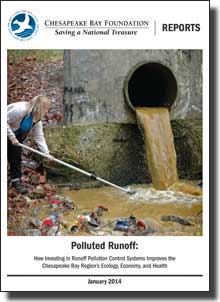What Is Runoff Pollution?
Polluted runoff is one of the most harmful sources of pollution to the Bay and its waters. And much of it starts right in the urban and suburban neighborhoods where we live.
As rainwater and snowmelt run off our streets, parking lots, lawns, and other surfaces, they pick up pet waste, pesticides, fertilizer, oil, and other contaminants. If the draining water doesn’t evaporate or soak into the ground where it can be filtered, it flushes straight into local creeks, rivers, and the Chesapeake Bay, adversely affecting water quality and aquatic life.
Only 10 to 20 percent of rain that falls in forests, fields, and other natural areas runs off, with the rest absorbed by soil and plants, where it is filtered before reaching aquifers or local waterways. By contrast, close to 100 percent of the rain that falls on concrete and other hard surfaces produces runoff. One inch of rain falling on an acre of hardened surface produces 27,000 gallons of runoff.
Agricultural runoff from farmland, which carries nutrients from fertilizers and animal manure into rivers and streams, is also a problem.
Why Is Stormwater Runoff Pollution Increasing in the Chesapeake Bay Watershed?
Polluted runoff from stormwater is one of the primary sources of pollution still on the rise in our region. The amount of land covered by parking lots, roads, roofs, and driveways continues to grow. Meanwhile, forests, meadows, wetlands, and other natural filters are disappearing, and manmade filtration systems to control runoff have not compensated for the loss.
What Are Examples of Runoff Pollution?
Stormwater runoff collects an often-toxic mix of pollutants including:
- Trash
- Soil and sediment
- Fecal bacteria, viruses, and other pathogens
- Nitrogen and phosphorus from fertilizers and air pollution
- Oil and other petroleum products
- Pesticides and herbicides
- Road salt
- Toxic metals including copper, lead, and zinc
Effects of Runoff Pollution
The effects of runoff pollution are vast and long-lasting. It erodes streams, kills fish, pollutes both drinking water and swimming areas, floods homes, and causes many other problems. It is literally changing the landscape of our watershed by
- Reshaping waterways. Strong currents of runoff scour stream banks, destabilizing the natural contours of the streams and even altering their depths.
- Endangering aquatic life. Besides carrying pollutants that harm fish and other creatures, runoff also includes eroded dirt that blocks sunlight from reaching underwater grasses and smothers the aquatic homes of oysters and other life. As grasses die, fish and other creatures that rely on them are placed in jeopardy. The runoff also carries nutrients that spur algal blooms that cause low oxygen and kill fish and other species.
Not only wildlife is endangered by stormwater pollution; residents of the watershed region are deeply affected, too. Polluted runoff from urban and suburban areas is
- Affecting water quality. Runoff muddies drinking water sources and can carry bacteria, making the treatment and use of such water more expensive.
- Contaminating recreation areas. Virginia and Maryland caution people not to swim in waterways for 48 hours after a heavy rain, as polluted runoff carrying bacteria has resulted in serious illnesses.
- Increasing flood damage. In urban and suburban areas with lots of hard surfaces, leaving polluted water with no place to go, local streets and basements often flood, causing repeated and costly damage to homes and businesses. With climate change potentially increasing the amount of precipitation and intensity of storms, localized flooding can increase as once designated "100-year storms" occur with greater frequency.
How to Prevent Runoff Pollution
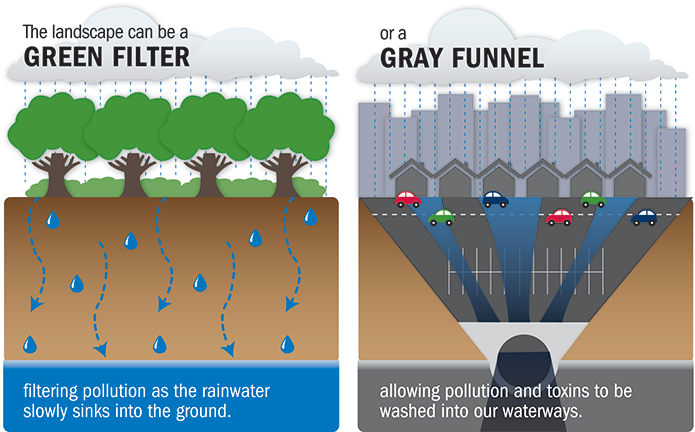
Chesapeake Bay Foundation
One promising solution to reducing runoff pollution in urban and suburban areas is to create “green infrastructure.” The idea is simple: Slow down and soak up the polluted runoff. Strategic greening efforts include
- planting rain gardens and other natural spaces in low-lying areas and in front of downspouts;
- attaching downspouts to rain barrels to collect rainwater, which can later be used for watering gardens;
- replacing old pavement with pervious pavement wherever possible;
- replacing grass with native plants;
- planting trees in yards, along streets, and along waterways; and
- planting gardens on rooftops.
These and other green solutions are cost-effective, beautify communities, and provide shade and wildlife habitat. We call this the “green filter” approach to managing runoff.
On agricultural lands, farmers can implement regenerative agriculture practices to reduce polluted runoff. These practices include
- planting forested buffers alongside streams;
- planting trees on land used for grazing;
- practicing rotational grazing, continuous no-till, and crop rotation;
- planting cover crops;
- managing fertilizer application; and
- using fences to keep livestock out of streams.
Agricultural cost-share programs provide farmers with critical federal and state funding to install these conservation practices. CBF's restoration staff work with farmers to install these practices.
CBF introduced local Bay jurisdictions to a new way of financing these green filters. It's called "impact investment." Projects help slow down and soak up runoff, and also create local sustainable jobs and more healthy, vibrant communities. Learn more about such a project in Hampton Roads, Virginia.
Did You Know
- The brake linings of cars and trucks are often made with copper and they shed a fine dust of this toxic metal onto streets, which can then end up in our waterways. The Maryland Department of the Environment sampled runoff from the state's major urban areas and found copper in 92 percent of the samples. Fifty-three percent of the time the levels would be acutely toxic to aquatic life. Another reason copper appears in waterways is because the metal is an ingredient in herbicides.
- Zinc from car tires, road salt, paint, and other products has also been found in runoff, as well as the toxic metals lead, chromium, and cadmium.
- Oil and other petroleum products in runoff are well known by scientists to be toxic to aquatic life, even in low concentrations.
- Researchers have detected pesticides including dieldrin and the now-banned chlordane in 97 percent of suburban and urban runoff samples nationally, and at levels high enough to harm aquatic life 83 percent of the time. For example, Lake Roland in Baltimore County is so polluted with chlordane, a termite-killing pesticide sprayed in nearby homes, that anglers are warned to limit their consumption of fish from the lake.
Additional information about stormwater management can be found at the following websites:
The Center for Watershed Protection
Low Impact Development Center
Low Impact Development Urban Design Tools
From Our Blog
-
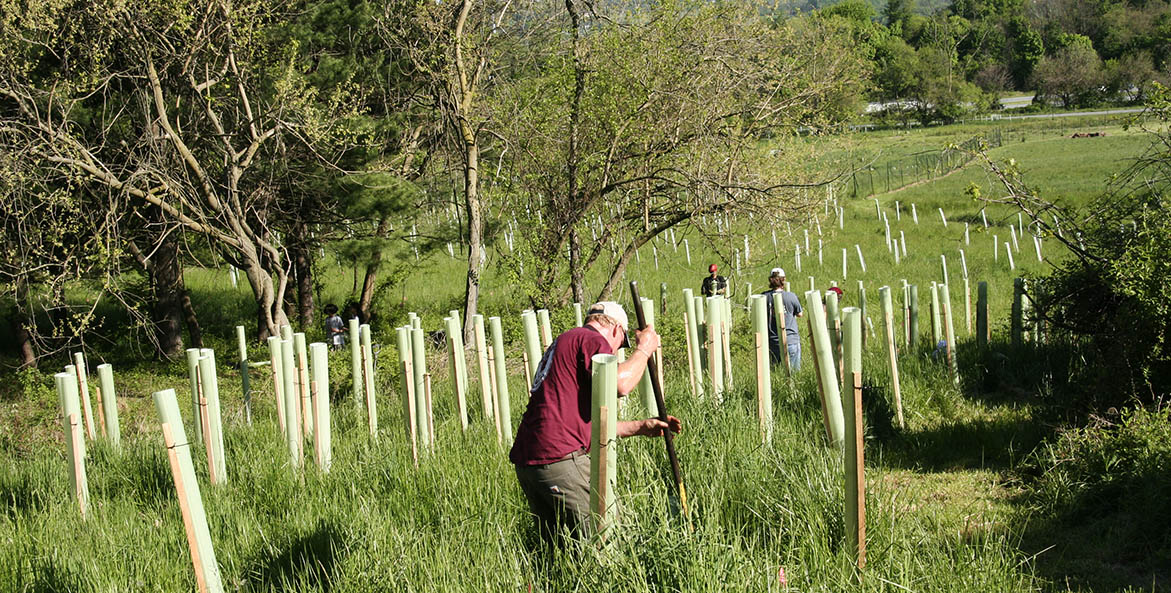
A New Year, a New Governor, a New Chance to Clean up the Chesapeake Bay
January 25, 2023
As one year ends and another begins, many of us have hope and optimism for the new year. In these early days of 2023, CBF is encouraged that momentum in 2022 can bring us closer to cleaner rivers and streams in Pennsylvania.
-
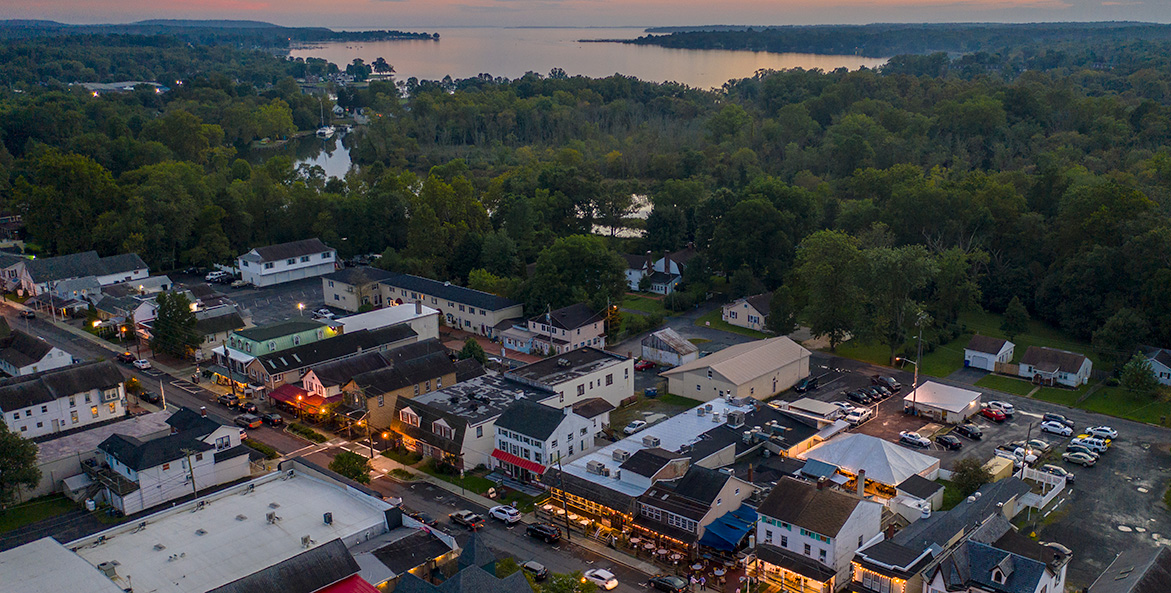
Five Things You Should Know from the 2022 State of the Bay Report
January 18, 2023
The Chesapeake Bay this month earned a D+ in CBF’s biennial report card assessing the watershed’s health. While the overall score remains unchanged from two years ago, there’s a lot going on below the surface. Here are five big takeaways.
-
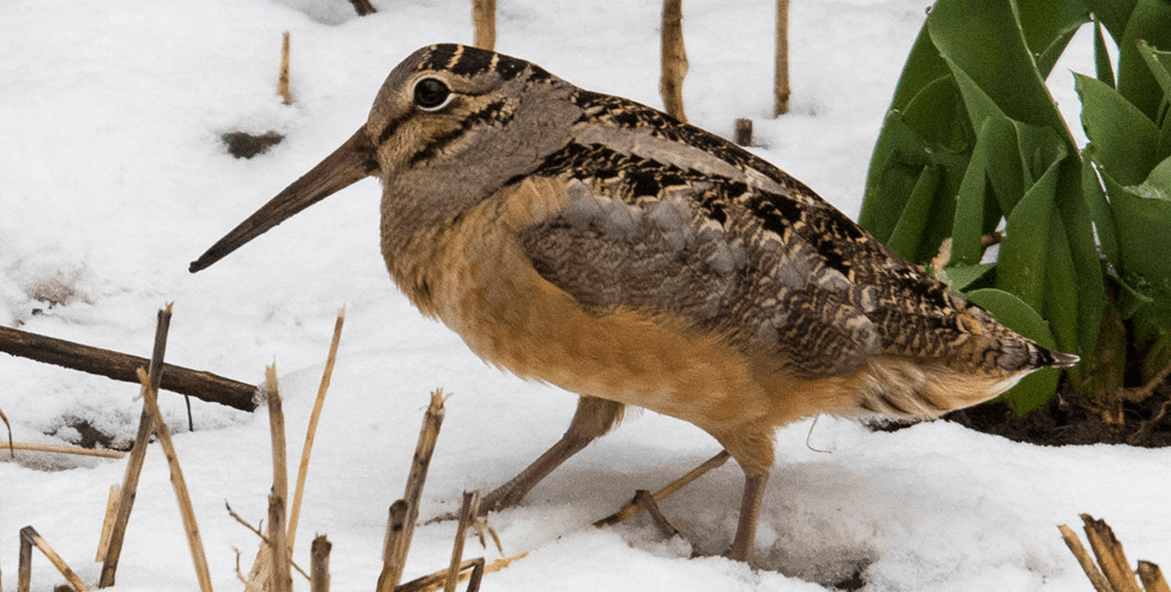
Clean Water Advocacy: December 2022 Update
December 29, 2022
Though a slower season for advocacy, the past three months saw some important developments on clean water issues across the watershed.
-
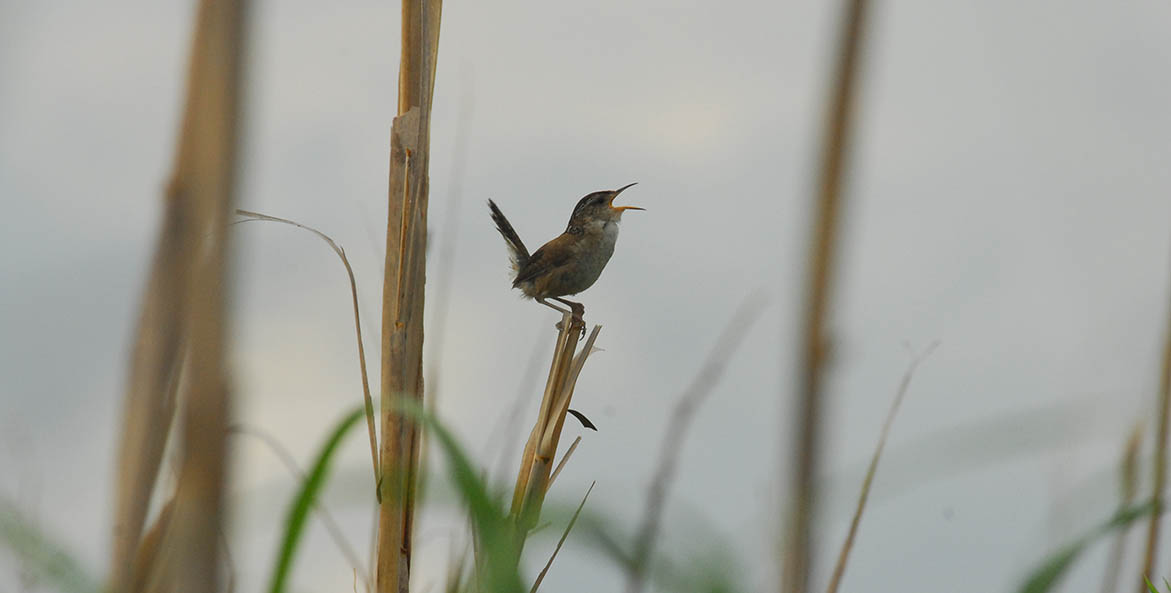
Top Five Advocacy Wins for the Bay in 2022
December 12, 2022
We look back at what clean water advocates accomplished across the watershed this year.
-
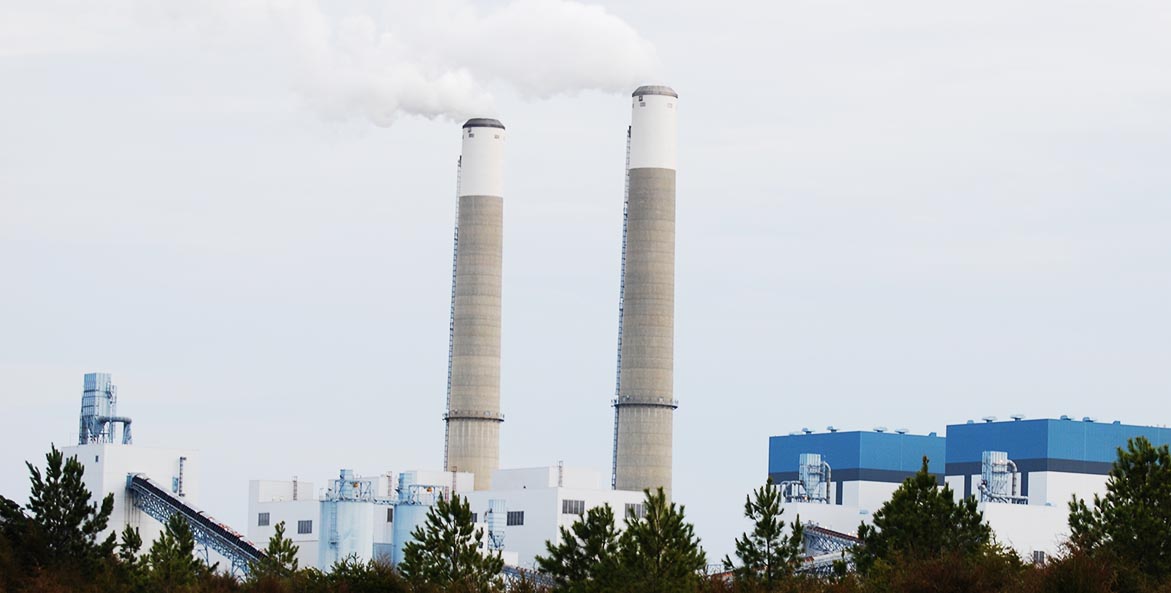
Groundbreaking Greenhouse Gas-Reduction Program at Risk in Virginia
December 7, 2022
By ending participation in the Regional Greenhouse Gas Initiative, often called RGGI, Virginia would lose a key tool for reducing air pollution from power plants, which contributes to pollution to the Bay.
| Items 6 - 10 of 20 | Previous | 1 | 2 | 3 | 4 | Next |
Video
-
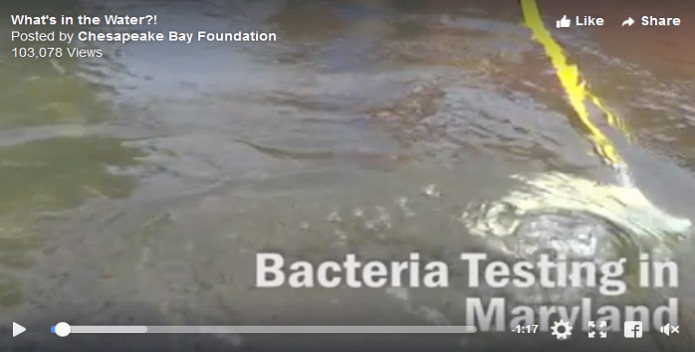
What's In the Water
24 Aug 2016 0:01:18In the summer of 2016, CBF tested bacteria levels in local Maryland streams after heavy rains, finding troubling results.
-
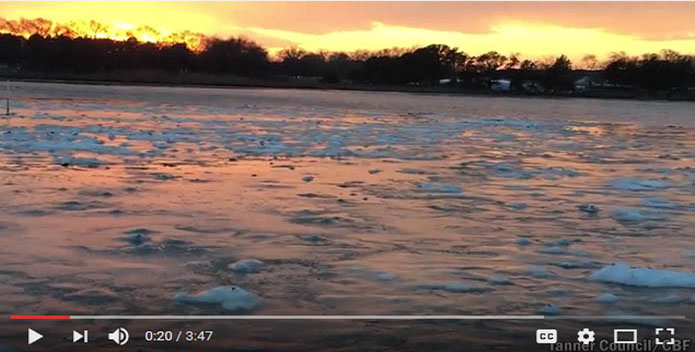
Road Salts and the Bay
21 Jan 2016 0:03:47CBF Senior Scientist Beth McGee explains how the road salts used during winter storms can affect the Bay and its rivers and streams.
-
Baltimore School Challenge
11 Nov 2015 0:02:43Kim Coble, Vice President for Environmental Protection and Restoration, delivers a challenge to design, innovate, and engineer solutions to stop nitrogen pollution from entering Baltimore's Inner Harbor.
| Items 4 - 6 of 8 | Previous | 1 | 2 | 3 | Next |


